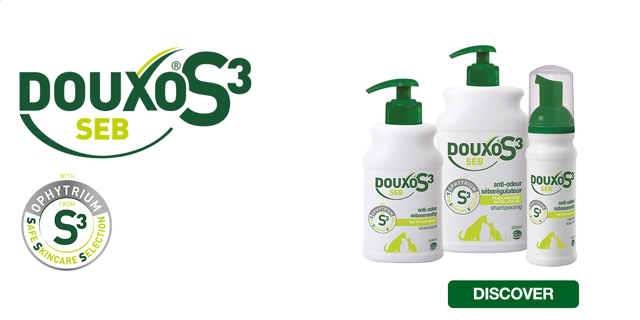When you think of dandruff, what comes to mind? Whatever it is, I’m sure it’s not on cats! Nevertheless, our furry friends can also suffer from this unsightly condition, for a myriad of reasons, even if it is quite uncommon. It can be due to some easy-to-solve causes but can sometimes be an early warning sign for serious health issues, so it’s important you learn how to treat cat dandruff at the source.
What is dandruff in cats?
Like dandruff in humans, the white flakes you’re seeing on Fluffy’s coat are just dead skin cells that have accumulated and not been removed by the cat. A mild case may be nothing to worry about and can be caused by something as innocuous as dry winter air or a stressful change in their environment.
When it’s time to see a vet for your cat’s dandruff
The most common sign is dry and flaky skin, either locally or more generally spread.
There are many underlying causes of cat dandruff that require medical attention such as obesity, skin infection, parasitic infestation, feline diabetes, endocrine disorders, other skin disorders, among others. But some others, such environment changes do not need it. If, in addition to the flakes or instead of, you’re seeing redness, greasy fur, raised scabs or scales, hair loss, excessive scratching, or other concerning symptoms, it’s probably time to see your vet for more exams.
How to cure cat dandruff: general treatment regime
Topical products to bring ingredients directly on the skin
These are essential products to bringing ingredients where they are needed. Some ingredients are able to regulate skin cell turnover, decreasing formation of flakes. We recommend using products like DOUXO® S3 SEB line, which are specially formulated to reduce dandruff, excess sebum and unpleasant odor thanks to the action of Seboliance, a natural extract. DOUXO® S3 SEB products hydrate dry skin, maintain proper skin hydration and prevent bacterial and fungal overgrowth. These are available as a shampoo and mousse, which should be combined (one shampoo followed by mousses) for an optimal performance. Mousse application through massages does not require rinsing which is an excellent news for all cat owners.
Coat brushing
Brushing with a slicker brush 2-3 times a week will help brush off dandruff, prevent mats, and make your kitty feel better.
What causes dandruff in cats and what is the best cat dandruff treatment?
When the dandruff, either localised or generalised, becomes so severe as to become worrisome, generally it is due to the cats not grooming themselves properly and/or an excessive amount of dead skin cells flaking off, faster than the cat can remove them. Let’s take a look at some of the more common causes.
Lack of self-grooming
Cats are usually meticulous creatures, spending hours grooming themselves in all kinds of fantastical positions. However, they sometimes have trouble reaching certain spots. This is especially true if your cat is overweight56;"> — like the base of the tail, that will then be prone dandruff, matted fur, and even infections. This is also true for older cats, who may additionally just not be as effective in their grooming as they were before.
How you can help:
If you have a cat who is obese, older, or has mobility problems and can no longer reach certain areas, you’ll need to step up and take over the grooming for those areas. To help your cat, the best way is to apply the general treatment regime with topical products and brushing.
Parasites and fungal infections
Even if your cat is an indoor cat, they can still get parasitic infections like fleas, mites (including those that cause walking dandruff), and internal parasites from other pets that come in and out of the house. If you suspect this could be the case and your cat is not on a reliable flea and tick preventative, see your vet for a definitive diagnosis. Cats can also get fungal infections like ringworm, which is treatable once detected with the help of your vet.
How you can help:
Your vet should be able to readily identify whatever pest is plaguing your cat and prescribe an effective treatment. They should always be kept up to date on a vet-approved flea and tick preventative and should be regularly dewormed.
Poor diet
If your cat’s dietary needs are not being met, for example, they are not getting the right ratio of fatty acids or are lacking other essential nutrients, this can manifest as a poor hair coat and/or dandruff. If your cat is on a low-fat diet to help them lose weight, this can also trigger dandruff.
How you can help:
Make sure that the food you are giving your feline is vet-recommended and consider rounding out their diet with fish oil or another omega-3 fatty acid supplement. If your chubby feline’s weight loss diet seems to be the culprit, you can use the general treatment regime as a support.
Dehydration
Strangely enough, cats are not the best at hydrating themselves. This is because physiologically they are equipped to get most of their water from their food, so the conditions they live in as domesticated animals, eating dry food, leaves them prone to suffering from dehydration. This, coupled with the dry winter air we use to heat our homes, can mean that some cats suffer from seasonal dandruff.
How you can help:
If you suspect dehydration is an issue, there are several things you can do to encourage your cat to ingest more water. In addition to the general treatment regime, you can supplement their diets with a high-quality wet food, providing them with more moisture. You can also think about making their water dish more appealing. They don’t call them finicky felines for nothing! Some cats prefer different types of dishes, and the best choices are usually stainless steel or ceramic bowls. The size of the bowl can also play a role, as some cats don’t like it if their whiskers touch the sides. You might also consider a water fountain. To combat dryness in the air, you can also try to use a humidifier in your home during the winter months.
Getting rid of cat dandruff: The bottom line
Luckily, this condition is easily remedied once its cause has been identified. With topical products, coat brush, and specific solutions depending on the cause your furry friend should be feeling less flaky in no time!




